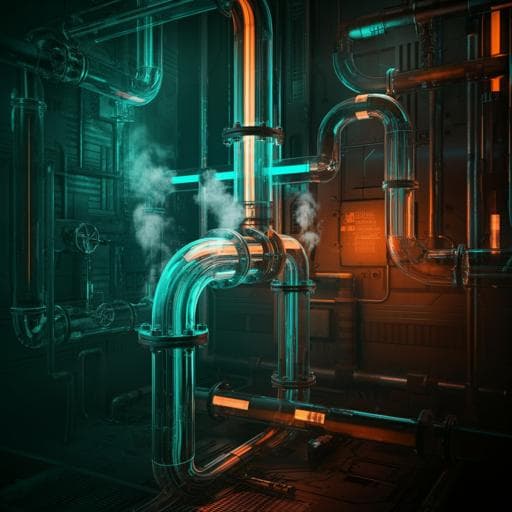
Engineering and Technology
Steam recovery from flue gas by organosilica membranes for simultaneous harvesting of water and energy
N. Moriyama, A. Takeyama, et al.
Discover how a groundbreaking system utilizing organosilica membranes can effectively recover steam and latent heat from waste gases in incinerator plants, promising solutions for water shortages and significant energy savings. This innovative research was conducted by Norihiro Moriyama and his team.
~3 min • Beginner • English
Introduction
The study addresses the dual challenges of industrial water scarcity and energy inefficiency by recovering water vapor and its latent heat from hot flue gases. Industrial sectors consume large amounts of water and energy, and flue gases commonly vent significant steam with high latent heat (e.g., 2.442 MJ kg−1 at 25 °C). Conventional plants typically release this steam without recovery, and in waste incineration, additional water is sprayed to rapidly cool combustion gases to avoid dioxin formation, further increasing steam losses and visible plumes. The authors propose integrating a vapor permeation (VP) steam-recovery membrane unit into waste incinerators and other plants. The concept selectively permeates steam to the permeate side, enabling recovery of latent (and sensible) heat and clean water for reuse, potentially eliminating the need for external water supply, suppressing stack plumes, and reducing energy consumption. They target the harsh hydrothermal, oxidative, and acidic conditions of real flue gases and motivate organosilica membranes as candidates capable of high-temperature steam-selective permeation with long-term stability.
Literature Review
Steam recovery membranes must tolerate hydrothermal, oxidizing, and acidic flue gas environments. Many conventional polymers (polyamide, polyimide, polyvinyl alcohol) lack stability above 150 °C. Earlier inorganic membranes (e.g., LTA zeolite, amorphous silica) often degrade under hydrothermal and/or acidic conditions. More recent materials (SOD, FAU, MOR, MFI zeolites; metal-doped silica; some perfluoropolymers) demonstrate steam-selective permeation at ≥150 °C, but reported upper steam permeance bounds near 10⁻⁶ mol m⁻² s⁻¹ Pa⁻¹ at 150–200 °C limited throughput. Prior work by the authors showed organosilica membranes with silsesquioxane networks achieving steam permeance 2–5 × 10⁻⁶ mol m⁻² s⁻¹ Pa⁻¹ and steam/nitrogen permeance ratios up to several hundred–thousand at 150–200 °C, with improved variants maintaining 4.7 × 10⁻⁶ mol m⁻² s⁻¹ Pa⁻¹ and H₂O/N₂ ≈ 350 under pressurized steam at 200 °C for over two weeks. This positions BTESE-derived organosilica membranes as promising candidates for robust steam recovery.
Methodology
Membrane fabrication: BTESE-derived organosilica membranes were prepared via sol-gel using bis(triethoxysilyl)ethane (BTESE) in ethanol with controlled hydrolysis/condensation and a pH-swing method. An α-alumina tubular support (avg. pore ~1 µm) was smoothed using α-alumina particles dispersed in BTESE swing sol and heat-treated at 300 °C (N₂). A BTESE-derived intermediate layer (~1 nm pores) was deposited, followed by a BTESE-acid sol separation layer, each heat-treated at 300 °C (N₂). The layered structure (support/intermediate/separation) provides sub-nanoporous, steam-selective transport via molecular sieving and surface diffusion. Laboratory test membranes included M-1 and M-2; a lab-scale membrane area of 3.1 × 10³ m² (picture) is shown; the bench-scale module used 22 membranes (12 plugged for flow adjustment), effective area 0.12 m².
Single-component permeation: Conducted at 200 kPa upstream and 100 kPa downstream for He, H₂, CO₂, N₂, CH₄, CF₄, SF₆, and steam. Steam was fully vaporized (~250 °C) to avoid condensation. Permeances were calculated by Π = Q / A(Pu − Pd).
Laboratory steam recovery tests (simulated waste gas): Glass evaporator, module, and lines were used to avoid corrosion. Simulated mixtures of H₂O with N₂ and/or air (O₂ present), plus HCl (tens to hundreds of ppm), were fed at 150–200 °C. Permeate steam was trapped and weighed; non-condensables quantified by flow after vacuum pump; HCl quantified by trapped mass and conductivity. Permeance in mixtures used Πi = Qi / A[(Pui − Pdi)m − (Pdi − Pasi)m] under recommended VP operating guidelines.
Long-term stability protocol: M-1 single-steam permeation at 150 °C for 9 days. M-2 under simulated waste: Days 0–35: H₂O/N₂ = 50/50 with 40 ppm HCl at 150 °C; Days 35–112: H₂O/air (50/40/10 H₂O/N₂/O₂) with 40 ppm HCl at 150 °C; Days 112–190: same composition at 200 °C; final assessment returned to 150 °C. Periodic binary (H₂O/N₂) and ternary (H₂O/N₂/HCl) evaluations were performed with downstream evacuated.
HCl concentration effect: Assessed permeance and selectivity vs HCl up to 400 ppm; baseline before/after without HCl verified no permanent degradation.
Bench-scale demonstration (running incinerator plant): A bypass from the plant duct supplied real flue gas (post-dust filter; properties in Table 1). A blower drew feed through the module; permeate passed a heat exchanger and condensate collected alternately in two tanks to fixed volumes; downstream maintained under vacuum. Temperatures, pressures, and humidity were monitored. Two daily cycles were tested; permeate amounts and durations yielded fluxes and permeances via the mixture permeance equation.
Process simulation: Counter-current, plug-flow model for quaternary H₂O/N₂/O₂/CO₂, using average flue gas conditions (Table 1) and membrane permeances from experiments (Fig. 3b). Differential mass balances dFi/dA = Πi(Pui − Pid) and dQi/dA = Πi(Pui − Pid) were integrated. Effective enthalpy recovery accounted for latent heat of condensed permeate at exchanger outlet temperature, sensible heat recovery of permeating species, and isothermal compression energy of permeating non-condensables. Dew point of retentate computed via Antoine equation. Sensitivity to membrane area and permeate cooling temperature (Te = 10, 25, 40 °C) was evaluated.
Key Findings
- Selectivity and sieving: Single-gas permeation at 200 °C showed strong size dependence; small gases permeate readily, confirming molecular sieving. Water’s kinetic diameter (~0.2955 nm) similar to H₂ (~0.289 nm), implying high steam permeance.
- Stability in steam: M-1 maintained ~6 × 10⁻⁶ mol m⁻² s⁻¹ Pa⁻¹ steam permeance over 9 days at 150 °C without decline.
- Long-term simulated flue gas test (M-2): Over 190 days under hydrothermal (150–200 °C), oxidative (air), and acidic (HCl up to 40 ppm) environments:
• After initial densification attributed to HCl, stable performance achieved by Day 23 at 150 °C.
• At Day 35 (150 °C): steam permeance ≈ 2.0 × 10⁻⁶ mol m⁻² s⁻¹ Pa⁻¹; H₂O/N₂ ≈ 200; H₂O/HCl ≈ 25.
• At Day 190 (back to 150 °C): steam permeance ≈ 2.3 × 10⁻⁶; H₂O/N₂ ≈ 170; H₂O/HCl ≈ 27. Downstream water purity >99.3%.
• At 200 °C (Days 112–190): no significant degradation; high permselectivity retained.
- HCl concentration effect: For HCl up to 400 ppm, steam, HCl, and N₂ permeances and associated selectivities were nearly independent of HCl concentration; baseline (no HCl) before/after showed no lasting damage.
- Mixed-gas selectivity: Steam permeance largely independent of non-condensable type; non-condensable permeance decreased with increasing molecular size, indicating sieving. Steam permeance exceeded H₂ despite slightly larger size, attributed to surface (condensed phase) diffusion.
- Bench-scale plant demonstration: Two-day continuous operation on real incinerator flue gas achieved steady steam recovery after ~1 h warm-up. Despite variable feed composition, retentate steam fraction consistently reduced relative to feed, confirming separation. Measured steam fluxes and permeances (several ×10⁻⁶ mol m⁻² s⁻¹ Pa⁻¹) matched laboratory evaluations.
- Process-level impacts and simulation (30 t d⁻¹ waste plant):
• Conceptual water balance: Of 24 t d⁻¹ waste-derived steam, plus sprayed water producing a total 98 t d⁻¹ steam post-filter, the membrane unit can recover ~74 t d⁻¹ steam and associated latent heat; recovered water is reused, achieving water self-reliance.
• Effective enthalpy recovery rises with membrane area; curves shown for permeate outlet temperatures of 10, 25, 40 °C. Energy recovery approximates 70% of waste combustion energy with appropriate sizing.
• Retentate is dehumidified, suppressing visible plume and avoiding reheating, saving ~22 GJ d⁻¹.
Overall, BTESE-derived organosilica membranes delivered high, durable steam-selective permeation under harsh flue gas conditions and validated the feasibility of simultaneous water and energy recovery in real plant conditions.
Discussion
The study demonstrates that organosilica membranes with tailored layered structures can robustly and selectively recover steam from harsh flue gas environments, directly addressing the need to conserve industrial water and capture otherwise lost latent and sensible heat. Long-term laboratory operation under hydrothermal, oxidative, and acidic conditions validated membrane durability and selectivity, while the bench-scale demonstration in a running incinerator confirmed consistent performance despite feed composition fluctuations. The high steam permeance relative to non-condensables, coupled with surface diffusion mechanisms, enables efficient vapor permeation at 150–200 °C. Process simulations using measured permeances and real flue gas properties indicate that integrating the membrane unit can close the water loop (self-reliant spraying water) and significantly recover useful heat—approaching 70% of waste combustion energy—while eliminating plume-related reheating needs. Compared with conventional approaches, the membrane unit provides a compact, thermal-stable, and chemically resilient solution that dehumidifies exhaust and recovers clean water and energy, with broad applicability to waste incineration, power generation, and chemical plants.
Conclusion
The work establishes a membrane-based strategy for simultaneous water and energy recovery from flue gases. BTESE-derived organosilica membranes exhibited high steam permeance (≈2–6 × 10⁻⁶ mol m⁻² s⁻¹ Pa⁻¹) and strong selectivity (H₂O/N₂ up to ~200 at 150–200 °C) with long-term stability over 190 days under hydrothermal, oxidative, and acidic conditions. Plant trials verified steady operation and alignment with laboratory permeances. Process simulations for a 30 t d⁻¹ waste incinerator predict water self-reliance (≈74 t d⁻¹ steam recovered for reuse) and substantial effective enthalpy recovery (up to ~70% of waste combustion energy), while mitigating exhaust plumes and saving additional energy. Future research should focus on scale-up of membrane modules and areas, extended long-term field trials across seasons and variable waste compositions, optimization of vacuum/compression and heat-exchange integration, management of trace contaminants over multi-year operation, and application to other industrial flue gas streams.
Limitations
- Bench-scale plant demonstration duration was limited (two days), so long-term field stability under real operating transients remains to be validated.
- Process simulations neglected ppm-level contaminants (e.g., SOx, NOx) which may affect performance over very long terms or require pretreatment.
- The demonstration module had a small effective area (0.12 m²); scale-up effects (pressure drops, module hydrodynamics, sealing) need assessment.
- Vacuum pump capacity limitations were noted (e.g., relatively high downstream pressure before pumping), suggesting that auxiliary equipment optimization could further improve efficiency estimates.
- Initial performance drift due to HCl-induced densification observed before stabilization highlights sensitivity to acid exposure during early operation.
Related Publications
Explore these studies to deepen your understanding of the subject.







